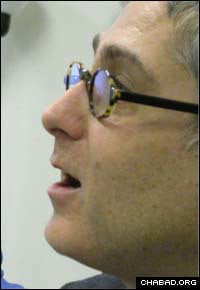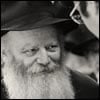For an academic body studying the nexus between religion and the media, a Chabad-Lubavitch archive and production outfit have become something of a test case of how a Chasidic Jewish community has embraced modern technology to document and preserve its modern legacy.
At their regular gathering in late December, 20 members of New York University's Working Group on Jews, Media and Religion examined Jewish Educational Media, which runs an archive of 4,000 hours of audiotapes and video footage of the Sixth Lubavitcher Rebbe, Rabbi Yosef Yitzchak Schneersohn, of righteous memory, and the Rebbe, Rabbi Menachem Mendel Schneerson, of righteous memory, dating back to the 1920s.
In its research, the working group – part of the university's Center for Religion and Media – struggles with a conspicuous gap in available resources. Chasidic communities tend to hold out against technological advances, making it difficult to find documentation of their early growth in America. Until recently, the consensus was that, save for a burst of activity in the 1990s among young Jewish artists who took up various mediums to explore several Chasidic communities from the outside looking in, documentary evidence of such group's early development in the United States was lacking.
Then Jewish Educational Media embarked on a preservation effort called "The Living Archive," which over the past two years has attracted the interest of academics and such bodies as the National Endowment for the Humanities.
"There is absolutely nothing to compare with the video and audio documentation of a religious Jewish community that [JEM] has collected," said Barbara Kirshenblatt-Gimblett, a professor of performance studies at NYU's Tisch School of the Arts and a co-convener of the religion and media working group at NYU.
Along with Jeffrey Shandler, a professor of Judaic studies at Rutgers University, Kirshenblatt-Gimblett invited JEM director Rabbi Elkanah Shmotkin to give a short presentation on the archive at the December meeting.
Shmotkin originally expected to roll several two-minute snippets of some of the Rebbe's public talks in Yiddish and then take questions from the floor. The discussion, which dwelled on the breadth of the collection and the history of Chabad-Lubavitch in America, ended up lasting for two hours.

"We are paying attention to how Chabad uses media, because these media are key to understanding Chabad's development," asserted Shandler. "Media will play a central role in its future."
Shmotkin said that the response of the academic community has been gratifying for a community that has always regarded its collection as central to preserving the thousands of talks that the Rebbe delivered during his more-than four decades of leadership until his passing in 1994.
"From a religious standpoint, the audio and video reels make up an obviously priceless anthology," explained Shmotkin. "It's been interesting to encounter a similar reverence in the academic and media perspectives."
At the working group's meeting, Shmotkin turned the discussion from an overview of JEM's collection to how the institution is preserving its future. He pointed out that as JEM embarked on its ambitious preservation effort, helped in part by a grant from the National Endowment for the Humanities, it continued to distribute the material in the form of DVD programs at a furious pace.
To date, more than 46 volumes of JEM's "Living Torah" programs – which include a portion of one of the Rebbe's many talks, footage of an exchange between the Rebbe and one of the hundreds of thousands of his weekly visitors and a short clip of the Rebbe singing a Chasidic melody with his followers – have been produced.
"Clearly an important issue now is Chabad's ongoing response to the passing of the Rebbe," suggested Shandler. "At the same time, there are works being created for the next generation of Chabad. [The two goals] are interrelated in an important way."







Start a Discussion